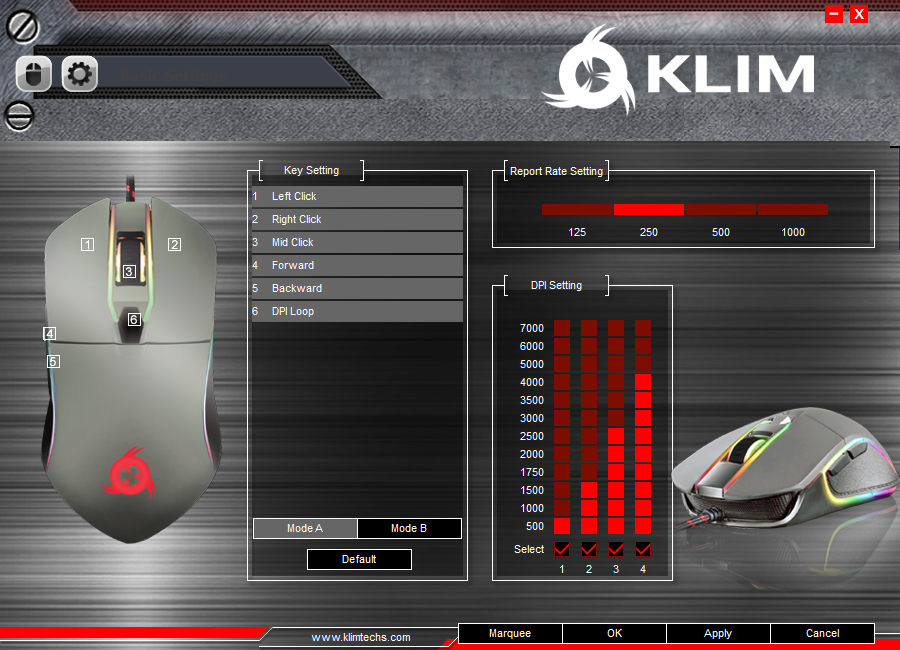If you're in the market for a mouse for some hardcore gaming, or you just like how gaming mice look, you'll come across a strange term called "DPI." But what does this term mean, and why should you care if your mouse has a toggleable DPI?
Let's break down what DPI means and how it can make using your mouse a more comfortable experience.
What Does DPI Stand For?
DPI stands for "Dots Per Inch," and it defines how far the cursor travels when you move your mouse. For mice, the "dots" that the initialism "DPI" refers to are the pixels on your monitor.
DPI in mice shouldn't be confused with DPI in printing. While they both stand for the same thing, the "dots" for printing refers to ink drops instead of pixels. You can read more about it in our guide on the ways to change the DPI of an image.
The DPI rating on a mouse is how many pixels your cursor moves when you move your mouse an inch across your desk. For instance, if you set your mouse to 1200DPI, it will move the cursor 1200 pixels per inch of hand movement.
If you bumped the setting up to 2400DPI, the cursor would move twice as far with the same hand movement.
Why Is Mouse DPI Important?
Mouse DPI matters because it makes your mouse easier and more comfortable to use. Even if you're just using your mouse for productivity purposes, having a toggleable DPI can be useful.
The Importance of Mouse DPI in Productivity
If you spend your workdays in front of a computer, having a comfortable mouse is important. You need one that can match your hand movements to a good level of cursor travel.
If you have a mouse with too low DPI, you have to make several full swipes of the mouse to get your cursor across the screen. Get a mouse with too high DPI, and you'll often overshoot buttons and icons that you want to click, and may even click the wrong thing entirely!
By getting your DPI into that "Goldilocks Zone," you have a cursor that moves without much wrist effort but is still precise enough for you to use quickly and efficiently. Once you find the right mouse for you, you can configure your mouse for additional comfort and a pain-free workday.
The Importance of Mouse DPI in Gaming
When playing games, your mouse and keyboard are key tools when controlling how you play. As such, getting a good mouse DPI can help boost how well you play.
A high DPI is great for gamers who want to make quick and sudden movements without much wrist motion. For instance, when whipping your character around 180 degrees to shoot whoever attacked you from behind.
If your DPI was too low, you'll end up throwing your arm across the entire table and knocking things off of it. A high DPI keeps your hand motions small and succinct for fast reaction times.
On the other hand, a low DPI is fantastic for pixel-based precision. While fast-paced games benefit from a high DPI, snipers will find it annoying that a minute hand movement will send their scope flying across the battlefield. By lowering the DPI, an inch of hand movement moves the scope only slightly, allowing for precise long-distance shots.
On top of all this, games typically come with a mouse sensitivity slider. Pros will often set their mouse to their preferred DPI, then fine-tune the sensitivity even further using the slider.
What DPI Setting Should You Use?
Unfortunately, there is no straight answer as to which DPI setting is best for you. There is no magic number to set your mouse to become instantly better at your games.
For one, the resolution of your monitor matters a great deal. Remember how DPI moves the mouse cursor a set amount of pixels per inch? This means a mouse will feel different if set to the same DPI but used on a larger resolution. That's because there are more pixels.
For instance, if you use an 800x600 resolution (and if you do, I'm very sorry), then an 800DPI mouse will go from the far left to the far right of the screen in a single inch of sideways motion. Do the same on a 3840 x 2160 resolution, however, and the same sideways motion will only get you about 20% of the way across the screen.
As such, you can't really say "X DPI is best for gaming," because you need to consider your screen's resolution as well as what kind of game you're playing. It's very much a case-by-case basis. Some pro gamers prefer a very low DPI in first-person shooters, ranging from around 400-800DPI, preferring to turn and maneuver to their target smoothly.
What you can do, however, is purchase a mouse with a wide range of DPIs. That way, you have a banquet of options to flip through and find the one that "feels right" for you. You can then go into the mouse sensitivity options in your OS or game and further tweak it to perfection.
In the above image, the mouse has four different DPI settings that the user can select with the click of a button. Then, each DPI level is also customizable from between 500DPI (which is relatively low) all the way up to 7,000DPI (which is incredibly fast).
Getting More From Your Mice
The term "DPI" doesn't really tell you a lot by itself, but it's an important aspect of mice that can make or break your comfort with one. Now you know what it means and how it may help you come work or play.
Now that you know what DPI means, how about checking out some gaming mice? There are plenty out there to choose from, and not all of them are as expensive as you may first think.
Image Credit: Mia Stendal / Shutterstock.com



